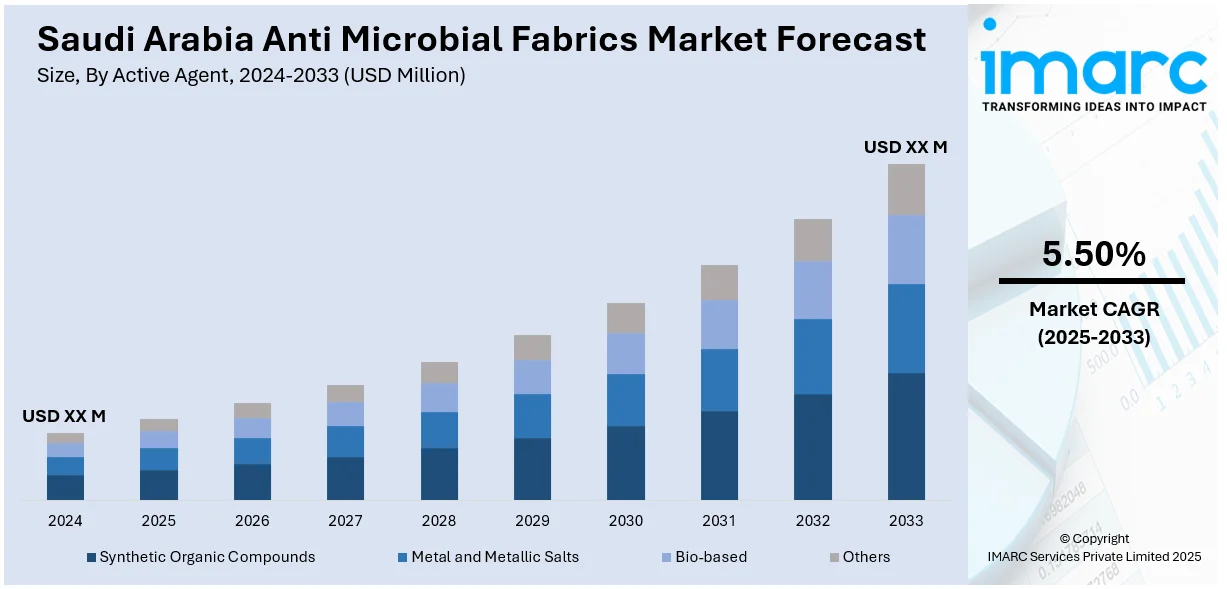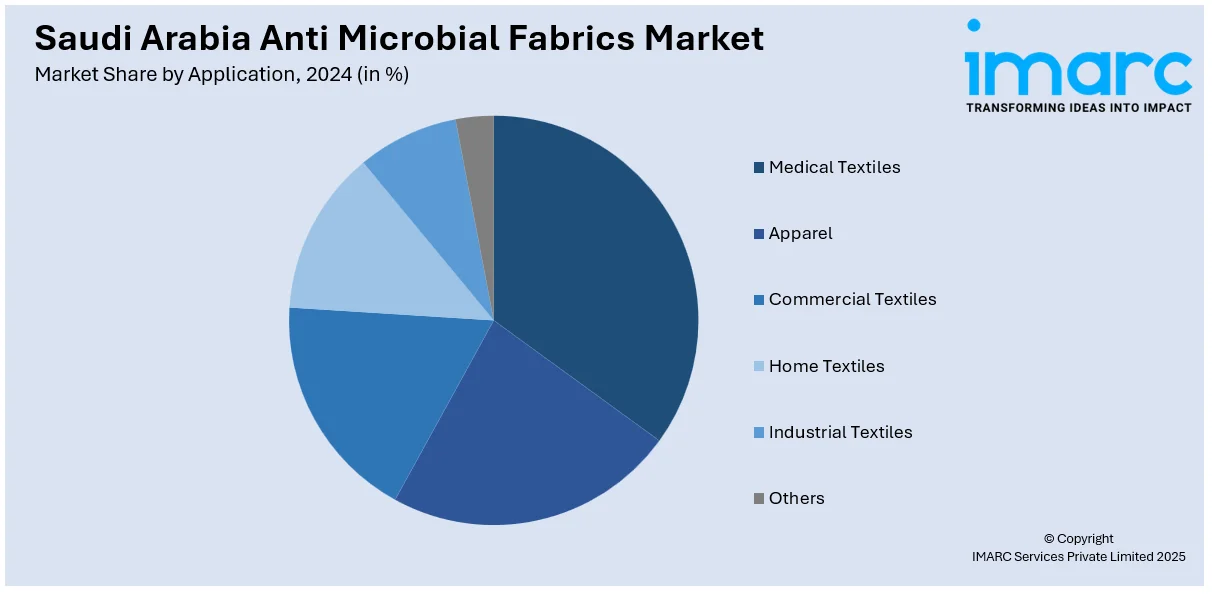
Saudi Arabia Anti Microbial Fabrics Market Size, Share, Trends and Forecast by Active Agent, Application, and Region, 2025-2033
Saudi Arabia Anti Microbial Fabrics Market Overview:
The Saudi Arabia anti microbial fabrics market size is projected to exhibit a growth rate (CAGR) of 5.50% during 2025-2033. Increased health and hygiene awareness, expansion of the healthcare sector, and increasing fashion and clothing demand are supporting the market growth. Further, rising demand for sustainable and eco-friendly products, textile technology innovation, and infection prevention demands in hospitals and healthcare facilities are propelling the market growth. Apart from this, the rise in disposable income, coupled with the growing middle class, is increasing consumer spending on high-quality fabrics, which is further driving the Saudi Arabia anti microbial fabrics market share.
|
Report Attribute
|
Key Statistics
|
|---|---|
|
Base Year
|
2024 |
|
Forecast Years
|
2025-2033
|
|
Historical Years
|
2019-2024
|
| Market Growth Rate 2025-2033 | 5.50% |
Saudi Arabia Anti Microbial Fabrics Market Trends:
Growing Awareness of Hygiene and Health
The primary driver for the market is the rising concern for health and hygiene. Consumers in the domestic and industrial sectors are becoming more concerned with living in a clean and hygienic environment. The COVID-19 pandemic hastened a rush in demand for enhanced hygiene, and this has fueled demand for the usage of materials that reduce bacterial and viral reproduction. This heightened focus on hygiene has created demand for antimicrobial textiles, as these are utilized in a variety of applications, from apparel and bedding to even household items like curtains and tablecloths. As consumers have sought fabrics that offer a second line of defense against potentially dangerous microorganisms, manufacturers have responded by incorporating antimicrobial treatments into their lines. In addition, the rise in infectious diseases and hospital-acquired infections (HAIs) created the need by healthcare institutions and consumers for protective fabrics against viruses and bacteria, hence driving the growth of the Saudi Arabia anti microbial fabrics market.

Expansion of the Healthcare Sector
The rapid development of the health sector in Saudi Arabia is the other key factor driving the market for antimicrobial fabrics. Saudi Arabia has heavily invested in the health infrastructure with a view to meeting the escalating needs of its expanding population. The Vision 2030 plan by the government includes plans for the improvement of healthcare services through the establishment of additional hospitals, clinics, and specialty medical facilities across the country. In 2024, the Saudi Ministry of Health announced the opening of 10 new hospitals and over 50 healthcare centers as part of its healthcare transformation strategy, reinforcing the country's commitment to accessible and high-quality medical care. When these health centers grow, the need for medical textiles offering greater protection against bacteria and viruses increases as well. Antimicrobial materials are now used widely in medical facilities, particularly for surgical gowns, bed sheets, patient uniforms, and even dressings, to aid in resisting infection and ensuring patient safety. As hospitals rely more and more on these textiles to reduce the possibility of infection, the demand for antimicrobial textiles will continue to increase.
Demand for Antimicrobial Fabrics in Fashion and Apparel
Increasing need for antimicrobial clothing in the fashion and clothing sectors of Saudi Arabia is driving the market. Consumers in Saudi Arabia are more concerned with knowing what their clothing is made of, and there are more and more consumers opting for garments with extra functionalities like antimicrobial clothing. Activewear and sports divisions are specifically witnessing strong demand for such clothing, where hygiene is an important aspect. Sports enthusiasts and gym users, for example, seek out garments that prevent the growth of bacteria, reduce odor, and increase ease of movement during exercise. Furthermore, Saudi Arabia's growing middle class is driving demand for quality, clean, and long-lasting garments. Antimicrobial textiles are also increasingly being utilized in everyday clothing, such as shirts, socks, and undergarments, where consumers want products that will keep them cool and resist the growth of bacteria.
Saudi Arabia Anti Microbial Fabrics Market Segmentation:
IMARC Group provides an analysis of the key trends in each segment of the market, along with forecasts at the country and regional levels for 2025-2033. Our report has categorized the market based on active agent and application.
Active Agent Insights:
- Synthetic Organic Compounds
- Metal and Metallic Salts
- Bio-based
- Others
The report has provided a detailed breakup and analysis of the market based on the active agent. This includes synthetic organic compounds, metal and metallic salts, bio-based, and others.
Application Insights:

- Medical Textiles
- Apparel
- Commercial Textiles
- Home Textiles
- Industrial Textiles
- Others
A detailed breakup and analysis of the market based on the application have also been provided in the report. This includes medical textiles, apparel, commercial textiles, home textiles, industrial textiles, and others.
Regional Insights:
- Northern and Central Region
- Western Region
- Eastern Region
- Southern Region
The report has also provided a comprehensive analysis of all the major regional markets, which include Northern and Central Region, Western Region, Eastern Region, and Southern Region.
Competitive Landscape:
The market research report has also provided a comprehensive analysis of the competitive landscape. Competitive analysis such as market structure, key player positioning, top winning strategies, competitive dashboard, and company evaluation quadrant has been covered in the report. Also, detailed profiles of all major companies have been provided.
Saudi Arabia Anti Microbial Fabrics Market News:
- In 2025, Saudi Arabia's Ministry of Health launched the second National Action Plan on Antimicrobial Resistance (2022–2025), focusing on improving data collection, monitoring AMR trends, and promoting responsible antimicrobial use in human and veterinary medicine.
Saudi Arabia Anti Microbial Fabrics Market Report Coverage:
| Report Features | Details |
|---|---|
| Base Year of the Analysis | 2024 |
| Historical Period | 2019-2024 |
| Forecast Period | 2025-2033 |
| Units | Million USD |
| Scope of the Report | Exploration of Historical Trends and Market Outlook, Industry Catalysts and Challenges, Segment-Wise Historical and Future Market Assessment:
|
| Active Agents Covered | Synthetic Organic Compounds, Metal and Metallic Salts, Bio-based, Others |
| Applications Covered | Medical Textiles, Apparel, Commercial Textiles, Home Textiles, Industrial Textiles, Others |
| Regions Covered | Northern and Central Region, Western Region, Eastern Region, Southern Region |
| Customization Scope | 10% Free Customization |
| Post-Sale Analyst Support | 10-12 Weeks |
| Delivery Format | PDF and Excel through Email (We can also provide the editable version of the report in PPT/Word format on special request) |
Key Questions Answered in This Report:
- How has the Saudi Arabia anti microbial fabrics market performed so far and how will it perform in the coming years?
- What is the breakup of the Saudi Arabia anti microbial fabrics market on the basis of active agent?
- What is the breakup of the Saudi Arabia anti microbial fabrics market on the basis of application?
- What is the breakup of the Saudi Arabia anti microbial fabrics market on the basis of region?
- What are the various stages in the value chain of the Saudi Arabia anti microbial fabrics market?
- What are the key driving factors and challenges in the Saudi Arabia anti microbial fabrics market?
- What is the structure of the Saudi Arabia anti microbial fabrics market and who are the key players?
- What is the degree of competition in the Saudi Arabia anti microbial fabrics market?
Key Benefits for Stakeholders:
- IMARC’s industry report offers a comprehensive quantitative analysis of various market segments, historical and current market trends, market forecasts, and dynamics of the Saudi Arabia anti microbial fabrics market from 2019-2033.
- The research report provides the latest information on the market drivers, challenges, and opportunities in the Saudi Arabia anti microbial fabrics market.
- Porter's five forces analysis assist stakeholders in assessing the impact of new entrants, competitive rivalry, supplier power, buyer power, and the threat of substitution. It helps stakeholders to analyze the level of competition within the Saudi Arabia anti microbial fabrics industry and its attractiveness.
- Competitive landscape allows stakeholders to understand their competitive environment and provides an insight into the current positions of key players in the market.
Need more help?
- Speak to our experienced analysts for insights on the current market scenarios.
- Include additional segments and countries to customize the report as per your requirement.
- Gain an unparalleled competitive advantage in your domain by understanding how to utilize the report and positively impacting your operations and revenue.
- For further assistance, please connect with our analysts.
 Request Customization
Request Customization
 Speak to an Analyst
Speak to an Analyst
 Request Brochure
Request Brochure
 Inquire Before Buying
Inquire Before Buying




.webp)




.webp)












